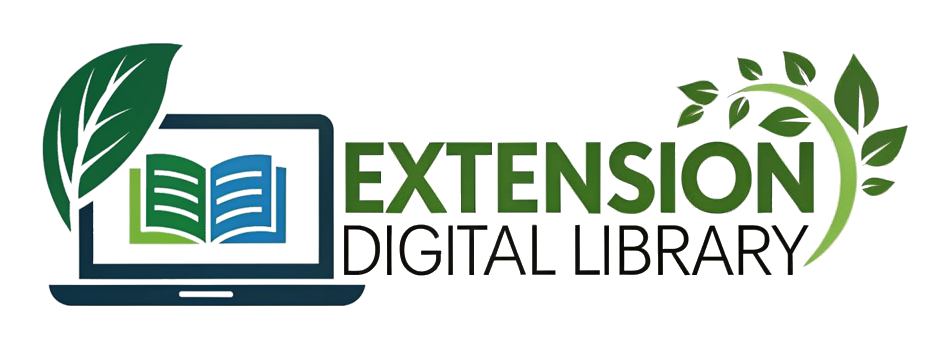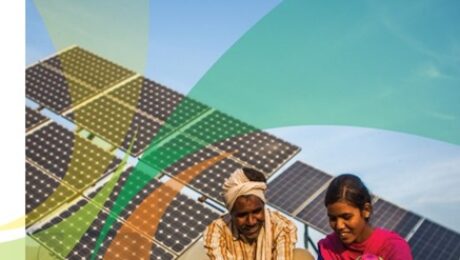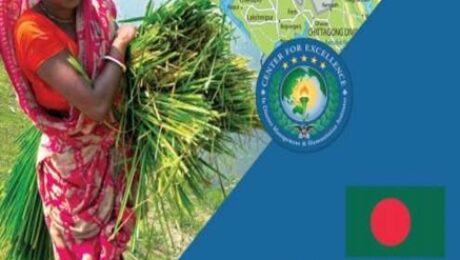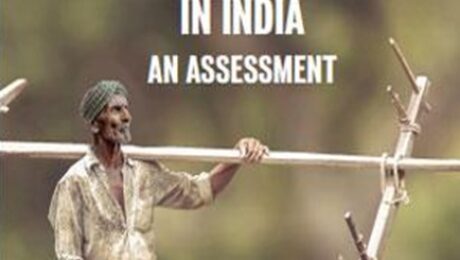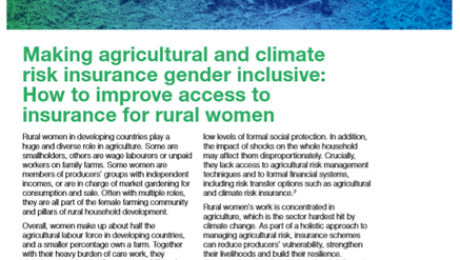Building climate resilience in degraded agricultural landscapes through water management
Rainfall variability and water scarcity continue to hamper the food and income security of smallholder farming systems in poverty-affected regions. Innovations in soil and water management, especially in the drylands, are critical for meeting food security and water productivity targets of Agenda 2030. This study analyzes how rainfed agriculture can be intensified with marginal impact on the landscape water balance. The impact of rainwater harvesting structures on landscape hydrology and associated agricultural services was analyzed in the semi-arid Jhansi district of Bundelkhand region in central India. The Parasai-Sindh pilot watershed was subjected to a 5-year (2012–2016) monitoring of rainfed system improvements in water availability and crop intensification due to surface water storage (haveli system), check dams, and field infiltration structures. Hydrological processes were monitored intensively to analyze the landscape’s water balance components. Rainwater harvesting (RWH) structures altered the landscape’s hydrology, limiting average surface runoff from 250 mm/year to 150 mm/year over the study period. Groundwater levels increased by 2–5 m (m), alleviating water scarcity issues of the communities in recurring dry years. Nearly 20% of fallow lands were brought under cultivation. Crop yields increased by 10–70% and average household income increased from US$ 960/year to US$ 2700/year compared to that in the non-intervention landscape. The combined soil–water–vegetation efforts strengthened water resilience and environmental systems in agricultural landscape.
- Published in CLIMATE CHANGE
Extension and Advisory Services for Climate-Smart Agriculture
Climate is turning out to be a prominent issue of concern nowadays. Climate change is the changing statistical distribution of the patterns that continues over years typically decades or longer. This climate change amplifies the threats like hunger, malnutrition, diseases, and poverty, thus affecting the progress of the world. Agriculture is the most vulnerable sector affected by climate change as it is highly dependent on local climatic parameters, such as rainfall, temperature, and soil health. It is the major driver of climate change. There is a high need to prevent the agriculture sector from being a prey to this climate change. It is time for agriculture to be “climate smart” for sustainably achieving the productivity and incomes and reducing the greenhouse emissions, wherever possible and to be resilient to climate change. Climate-smart agriculture (CSA) is an integrated approach that can address several challenges interlinked with climate change. This concept now has a wide ownership among the national and international agencies, government, and civil societies with a strong focus. Though CSA has been gaining importance, its dissemination and uptake of climate-smart technologies, tools, and practices are still largely an ongoing and challenging process. The adaptation of climate-related knowledge, technologies, and practices based on regional requirements, promoting a coordinated learning by farmers, researchers, extension workers, and the wide dissemination of CSA practices, is possible through the extension to an extent. Extension and advisory services can bridge the knowledge gap by providing clarity on CSA components and its relevant issues. They also play a vital role in helping farmers to cope with the diverse impacts of climate change by creating awareness by using appropriate tools to make them aware about different adaptation and mitigation strategies. This chapter provides a detailed description of how this rural advisory services and extension systems aid in climate-smart agriculture. The novel extension approaches like the information and communication technology (ICT)-enabled extension services and climate information services help the farmers at grass root level. The promising innovative extension approaches that are required to be adopted for the changing climate are enlisted to achieve CSA.
- Published in CLIMATE CHANGE
Actions to Transform Food Systems Under Climate Change
This is the overarching message from the wealth of literature on food systems.1 Analysis by Bene and colleagues finds that this growing body of literature focuses on four main types of failures: food systems’ inability
(i) to produce greater quantities of food to feed a growing world population, (ii) to meet nutritional needs, and (iii) to benefit everyone equally and equitably, with both over- and underconsumption rife in current food systems, plus (iv) the negative impacts of food systems on the environment and natural resources.1
Last but far from least, climate change is increasingly having severe negative impacts on food systems, while food systems themselves are part of the problem through direct and indirect emissions.2 Our score for the global food system: cause for grave concern.
- Published in CLIMATE CHANGE
Bangladesh: Disaster Management Reference Handbook, May (2020)
Bangladesh has been affected by more than 200 natural disasters over the last three decades. The country’s geographical location next to the Bay of Bengal, low-lying terrain, monsoons, and significant rivers render the country very vulnerable to natural hazards. From 1970-2019, storms have been the most frequent disaster to affect Bangladesh at 52%, followed by floods at 31%, with the remaining disasters being epidemics, earthquakes, droughts, and landslides.7 In addition, Bangladesh is one of the countries in the world most at risk from the negative impacts of climate change including increases in incidence and intensity of extreme weather events and hazards such as soil salinization, rising sea levels and riverbank erosion.8 Bangladesh has many sources of vulnerability including earthquakes and flooding. Traffic in Dhaka is among the most congested in the world.
An earthquake heavily affecting the capital is among the more challenging disaster scenarios.9 In addition, the flood damage potential is increasing due to climate change, urbanization, growth of settlements in flood-prone areas and over reliance on flood control works such as levees and reservoirs.10 Growing urbanization is driven partly by migration and has contributed to straining the use of limited land, environment, and fragile infrastructure. Migration toward urban areas is in turn driven partially by climate change exacerbating flooding of formerly inhabited land around river delta areas. These emerging risks present major challenges to the continued human development, poverty reduction and economic growth of the country, and to the lives, livelihoods, and health of its people.
- Published in CLIMATE CHANGE
Agrometeorological Advisory Services India
CSE releases new report on agromet advisory systems – focusing on weather data collection and forecasting, agricultural expertise and analysis of crop data, leading to generation of practical advice for farmers.
The agricultural sector is the foundation of the Indian economy. It employs more than 50 per cent of India’s workforce and contributes almost 17–18 per cent of its GDP.1 At present, agricultural livelihoods are being severely impacted world over as a result of anthropogenic global warming and climate change. India’s labour-intensive and subsistence-based agriculture sector is particularly vulnerable to this development.
Climate change has both direct and indirect effects on agricultural productivity, including changing rainfall patterns, severe drought, flooding and changes in the geographical redistribution of pests and diseases.2 These impacts are highly unevenly distributed across the globe, with regions like South Asia (including India) and sub-Saharan Africa experiencing significantly more adverse effects than North America, Europe (particularly Eastern Europe) and South America.
- Published in CLIMATE CHANGE
Research on Impacts of Climate Change on Bangladesh Agriculture: A KGF Initiative
This effort by KGF to publish a booklet on Climate Change Impact Assessment on Bangladesh Agriculture : A KGF Initiative narrating the outcomes of collaborative research by BARI, BRRI and BSMRAU scientists, sponsored and facilitated by KGF, is a welcome development towards dissemination of scientific information on a pressing national and global issue.
- Published in CLIMATE CHANGE
Adapt Now: A Global Call for Leadership on Climate Resilience
This report focuses on making the case for climate adaptation, providing specific insights and recommendations in key sectors: food security, the natural environment, water, cities and urban areas, infrastructure, disaster risk management, and finance. It is designed to inspire action among decision-makers, including heads of state and government officials, mayors, business executives, investors, and community leaders.
- Published in CLIMATE CHANGE
A compendium of Technologies, Practices, Services and Policies for Scaling Climate Smart Agriculture in Odisha (India)
Stakeholders engaged in agricultural research for development (AR4D) are increasingly tackling risks associated with climate change in smallholder systems. Accordingly, development and scaling of climate-smart agriculture (CSA) are one of the priorities for all the organizations, departments and ministries associated with the farm sector. Having a ‘one-stop-shop’ compiled in the format of a compendium for CSA technologies, practices and services would therefore serve a guide for all the stakeholders for scaling CSA in smallholder systems.
- Published in CLIMATE CHANGE
IN BRIEF Making agricultural and climate risk insurance gender inclusive: How to improve access to insurance for rural women
IFAD’s technical assistance programme INSURED (Insurance for rural resilience and economic development) has been building knowledge about how to strengthen women producers’ access to climate risk insurance. Working with partners, INSURED supported research, and fieldwork in Ethiopia including group discussions with smallholders about insurance options. A checklist was drawn up for insurance designers and implementers to help them reach out to women every step of the way.
- Published in CLIMATE CHANGE
Compendium of Climate-Resilient Agriculture Technologies and Approaches in the Philippines
This Compendium of Climate-Resilient Agriculture Technologies and Approaches in the Philippines has been produced in response to the need to provide science-based and actionable knowledge on climate-resilient agricultural technologies and practices in different agroecological systems in the Philippines. The compendium aims to better guide policymakers, farmer organizations, researchers, extension workers, and the agribusiness sector, as well as climate-smart agriculture practitioners. It does not only present a menu of solutions but more importantly, it proposes that a business-as-usual attitude is no longer an option if we want to protect the future of our food supply and the well-being of the farmers and communities that produce it.
- Published in CLIMATE CHANGE
